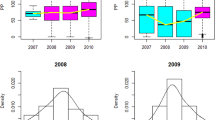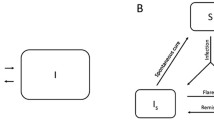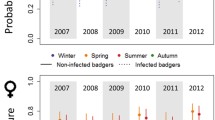Abstract
Modeling infectious diseases data is a relatively young research area in which clustering and stratification are key features. It is not unlikely for these data to have missing values. If values are missing completely at random, the analysis on the complete cases is valid. However, in practice this assumption is usually not fulfilled. This article shows the effect of ignoring missing data in modeling the force of infection of the bovine herpesvirus-1 in Belgian cattle and proposes the use of weighted generalized estimating equations with constrained fractional polynomials as a flexible modeling tool.
Similar content being viewed by others
References
Aerts, M., Geys, H., Molenberghs, G., and Ryan, L. M. (2002), Topics in Modeling of Clustered Data, London: Chapmann and Hall.
Anderson, R. M., and May, R. M. (1991), Infectious Diseases of Humans: Dynamic and Control, Oxford: Oxford University Press.
Becker, N. G. (1989), Analysis of Infectious Diseases Data, London: Chapman and Hall.
Boelaert, F., Biront, P., Soumare, B., Dispas, M., Vanopdenbosch, E., Vermeersch, J., Raskin, A., Dufey, J., Berkvens, D., and Kerkhofs, P. (2000), “Prevalence of Bovine Herpesvisus-1 in the Belgian Cattle Population,” Preventive Veterinary Medicine, 45, 285–295.
Boelaert, F., Speybroeck, N., de Kruif, A., Aerts, M., Burzykowski, T., Molenberghs, G., and Berkvens, D. L. (2005), “Risk Factors for Bovine Herpesvirus-1 Seropositivity,” Preventive Veterinary Medicine, 69, 285–295.
Faes, C., Geys, H., Aerts M., and Molenberghs, G. (2003), “On the Use of Fractional Polynomial Predictors for Quantitative Risk Assessment in Developmental Toxicity Studies,” Statistical Modelling, 3, 109–126.
Faes, C., Hens, N., Aerts, M., Shkedy, Z., Geys, H., Mintiens, K., Laevens, H., and Boelaert, F. (2006), “Population-Averaged Versus Herd-Specific Force of Infection,” Applied Statistics, 55, 595–613.
Grenfell, B. T., and Anderson, R. M. (1985), “The Estimation of Age-Related Rates of Infection from Case Notifications and Serological Data,” Journal of Hygiene, 95, 419–36.
Grummer-Strawn, L. M. (1993), “Regression Analysis of Current Status Data: An Application to Breast Feeding,” Biometrika, 72, 527–537.
Hens, N., Aerts, M., and Molenberghs, G. (2006), “Model Selection for Incomplete and Design-Based Samples,” Statistics in Medicine, 25, 2502–2520.
Jewell, N. P., and Van Der Laan, M. (1995), “Generalizations of Current Status Data with Applications,” Lifetime Data Analysis, 1, 101–109.
Keiding, N., Begtrup, K., Scheike, T. H., and Hasibeder, G. (1996), “Estimation from Current Status Data in Continuous Time,” Lifetime Data Analysis, 2, 119–129.
Liang, K., and Zeger, S. (1986), “Longitudinal Data Analysis using Generalized Linear Models,” Biometrika, 73, 13–22.
Little, R., and Rubin, D. (1987), Statistical Analysis with Missing Data, New York: Wiley.
Little, R. J. (2004), “To Model or not to Model? Competing Modes of Inference for Finite Population Sampling,” Journal of the American Statistical Association, 99, 546–556.
McCullagh, P., and Nelder, J. (1989), Generalized Linear Models, New York: Chapman & Hall.
McDonald, B. W. (1993), “Estimating Logistic Regression Parameters for Bivariate Binary Data,” Journal of the Royal Statistical Society, Series B, 55, 391–397.
Robins, J., Rotnitzky, A., and Zhao, L. (1994), “Estimation of Regression Coefficients when Some Regressors are not Always Observed,” Journal of the American Statistical Association, 89, 846–866.
Royston, P., and Altman, D. (1994), “Regression Using Fractional Polynomials of Continuous Covariates: Parsimonious Parametric Modelling,” Applied Statistics, 43, 429–467.
Rubin, D. (1978), “Multiple Imputations in Sample Surveys—A Phenomenological Bayesian Approach to Nonresponse,” Imputation and Editing of Faulty or Missing Survey Data, Washington, DC: U.S. Department of Commerce, 1–23
Shanno, D. F. (1985), “On Broyden-Fletcher-Goldfarb-Shanno Method,” Journal of Optimization Theory and Applications, 46, 87–94.
Shkedy, Z., Aerts, M., Molenberghs, G., Beutels, P., and Van Damme, P. (2003), “Modelling Forces of Infection by Using Monotone Local Polynomials,” Applied Statistics, 52, 469–485.
— (2006) “Modeling Age Dependent Force of Infection from Prevalence Data Using Fractional Polynomials,” Statistics in Medicine, 9, 1577–1591.
Speybroeck, N., Boelaert, F., Renard, D., Burzykowski, T., Mintiens, K., Molenberghs, G., and Berkvens, D. L. (2003), “Design-Based Analysis of Surveys: A Bovine Herpesvirus 1 Case Study,” Epidemiology and Infection, 131, 991–1002.
Williamson, J. M., Datta, S., and Satten, G. A. (2003), “Marginal Analyses of Clusterd Data when Cluster Size is Informative,” Biometrics, 59, 36–42.
Wood, S. N. (2000), “Modelling and Smoothing Parameter Estimation with Multiple Quadratic Penalties,” Journal of the Royal Statistical Society, Series B, 62, 413–428.
— (2004), “Stable and Efficient Multiple Smoothing Parameter Estimation for Generalized Additive Models,” Journal of the American Statistical Association, 99, 673–686.
Wood, S. N., and Augustin, N. H. (2002), “Gams with Integrated Model Selection Using Penalized Regression Splines and Applications to Environmental Modelling,” Ecological Modelling, 157, 157–177.
Zeger, S. L., Liang, K. Y., and Albert, P. S. (1988), “Models for Longitudinal Data: A Generalized Estimating Equation Approach,” Biometrics, 44, 1049–1060.
Zhao, L. P., and Lipsitz, S. (1992), “Design and Analysis of Two-Stage Studies,” Statistics in Medicine, 11, 769–782.
Zhao, L. P., Lipsitz, S., and Lew, D. (1996), “Regression Analysis with Missing Covariate Data using Estimating Equations,” Biometrics, 52, 1165–1182.
Author information
Authors and Affiliations
Corresponding author
Rights and permissions
About this article
Cite this article
Hens, N., Faes, C., Aerts, M. et al. Handling missingness when modeling the force of infection from clustered seroprevalence data. JABES 12, 498–513 (2007). https://doi.org/10.1198/108571107X250535
Received:
Revised:
Issue Date:
DOI: https://doi.org/10.1198/108571107X250535




